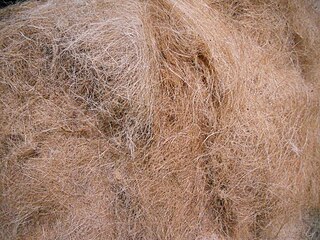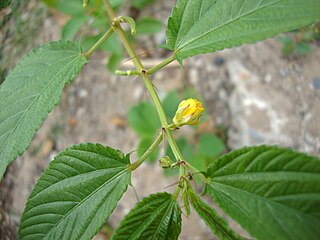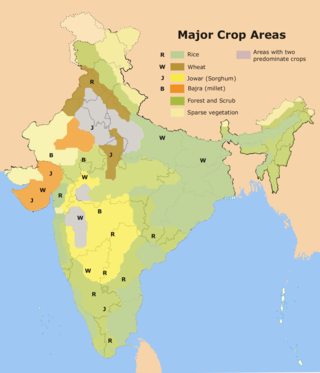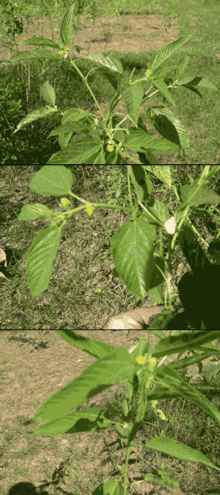
Flax, also known as common flax or linseed, is a flowering plant, Linum usitatissimum, in the family Linaceae. It is cultivated as a food and fiber crop in regions of the world with temperate climates. Textiles made from flax are known in English as linen and are traditionally used for bed sheets, underclothes, and table linen. Its oil is known as linseed oil. In addition to referring to the plant, the word "flax" may refer to the unspun fibers of the flax plant. The plant species is known only as a cultivated plant and appears to have been domesticated just once from the wild species Linum bienne, called pale flax. The plants called "flax" in New Zealand are, by contrast, members of the genus Phormium.

Linen is a textile made from the fibers of the flax plant.

Coir, also called coconut fibre, is a natural fibre extracted from the outer husk of coconut, and used in products such as floor mats, doormats, brushes, and mattresses. Coir is the fibrous material found between the hard, internal shell and the outer coat of a coconut. Other uses of brown coir are in upholstery padding, sacking and horticulture. White coir, harvested from unripe coconuts, is used for making finer brushes, string, rope and fishing nets. It has the advantage of not sinking, so can be used in long lengths in deep water without the added weight dragging down boats and buoys.

Jute is a long, rough, shiny bast fibre that can be spun into coarse, strong threads. It is produced from flowering plants in the genus Corchorus, of the mallow family Malvaceae. The primary source of the fiber is Corchorus olitorius, but such fiber is considered inferior to that derived from Corchorus capsularis.

The Indo-Gangetic Plain, also known as the North Indian River Plain, is a 700-thousand km2 (172-million-acre) fertile plain encompassing northern regions of the Indian subcontinent, including most of modern-day northern and eastern India, most of eastern-Pakistan, virtually all of Bangladesh and southern plains of Nepal. Also known as the Indus–Ganga Plain, the region is named after the Indus and the Ganges rivers and encompasses a number of large urban areas. The plain is bounded on the north by the Himalayas, which feed its numerous rivers and are the source of the fertile alluvium deposited across the region by the two river systems. The southern edge of the plain is marked by the Deccan Plateau. On the west rises the Iranian Plateau. Many developed cities like Delhi, Dhaka, Kolkata, Lahore, Islamabad and Karachi are located in the Indo-Gangetic Plain.

Kenaf [etymology: Persian], Hibiscus cannabinus, is a plant in the family Malvaceae also called Deccan hemp and Java jute. Hibiscus cannabinus is in the genus Hibiscus and is native to Africa, though its exact origin is unknown. The name also applies to the fibre obtained from this plant. Kenaf is one of the allied fibres of jute and shows similar characteristics.

Fiber crops are field crops grown for their fibers, which are traditionally used to make paper, cloth, or rope.

The Ganges Delta is a river delta in Eastern South Asia predominantly covering the Bengal region of the subcontinent, consisting of Bangladesh and the Indian state of West Bengal. It is the world's largest river delta and it empties into the Bay of Bengal with the combined waters of several river systems, mainly those of the Brahmaputra river and the Ganges river. It is also one of the most fertile regions in the world, thus earning the nickname the Green Delta. The delta stretches from the Hooghly River east as far as the Meghna River.
Retting is a process employing the action of micro-organisms and moisture on plants to dissolve or rot away much of the cellular tissues and pectins surrounding bast-fibre bundles, facilitating the separation of the fibre from the stem. It is used in the production of linen from flax stalks and coir from coconut husks.

Bast fibre is plant fibre collected from the phloem or bast surrounding the stem of certain dicotyledonous plants. It supports the conductive cells of the phloem and provides strength to the stem. Some of the economically important bast fibres are obtained from herbs cultivated in agriculture, as for instance flax, hemp, or ramie, but bast fibres from wild plants, as stinging nettle, and trees such as lime or linden, willow, oak, wisteria, and mulberry have also been used in the past. Bast fibres are classified as soft fibres, and are flexible. Fibres from monocotyledonous plants, called "leaf fibre", are classified as hard fibres and are stiff.

The Geography of West Bengal, a state in eastern India, is primarily defined by plains and plateaus, with the high peaks of the Himalayas in the north and the Bay of Bengal to the south.

Corchorus capsularis, commonly known as white jute, is a shrub species in the family Malvaceae. It is one of the sources of jute fibre, considered to be of finer quality than fibre from Corchorus olitorius, the main source of jute. The leaves are used as a foodstuff and the leaves, unripe fruit and the roots are used in traditional medicine.

Jute mallow or Nalita jute is a species of shrub in the family Malvaceae. Together with C. capsularis it is the primary source of jute fiber. The leaves and young fruits are used as a vegetable, the dried leaves are used for tea and as a soup thickener, and the seeds are edible.

Bamboo textile is any cloth, yarn or clothing made from bamboo fibres. While historically used only for structural elements, such as bustles and the ribs of corsets, in recent years different technologies have been developed that allow bamboo fibre to be used for a wide range of textile and fashion applications.

Rice production in India is an important part of the national economy.

Scutching is a step in the processing of cotton or the dressing of flax or hemp in preparation for spinning. The scutching process separates the impurities from the raw material, such as the seeds from raw cotton or the straw and woody stem from flax fibers. Scutching can be done by hand or by a machine known as a scutcher. Hand scutching of flax is done with a wooden scutching knife and a small iron scraper. The end products of scutching flax are the long finer flax fibers called line, short coarser fibers called tow, and waste woody matter called shives.
Kamrun Nahar is a Bangladeshi soil scientist and environmentalist. A prominent biofuels researcher of Bangladesh, her research and publications also aimed to lower dependence on petroleum based foreign oil by producing low carbon and sulphur emitting biofuels from the second generation energy crops cultivated in the unused wastelands of Bangladesh for use in home generators to supplement power.

Setralit is a technical natural fiber based on plant fibers whose property profile has been modified selectively in order to meet different industrial requirements. It was first manufactured in 1989 by Jean-Léon Spehner, an Alsatian engineer, and further developed by the German company ECCO Gleittechnik GmbH. The name “Setralit“ is derived from the French company Setral S.à.r.l. which is a subsidiary company of ECCO, where Spehner was employed at that time. Setralit was officially described first in 1990.

Bangladesh is an important tea-producing country. It is the 12th largest tea producer in the world. Its tea industry dates back to British rule, when the East India Company initiated the tea trade in the hills of the Sylhet region. In addition to that, tea cultivation was introduced to Greater Chittagong in 1840. Today, the country has 166 commercial tea estates, including many of the world's largest working plantations. The industry accounts for 3% of global tea production, and employs more than 4 million people.

Linum strictum, commonly known as rigid flax, upright flax, and upright yellow flax, is a species of flax with a rigid stem, from whence it derives its taxonomic name, growing to a height of 10–45 cm. The plant is endemic to the Mediterranean region. It features highly in classical Hebrew and Greek literature, owing principally to its cultivation for its plant fiber, linen, but also for its edible seeds and culinary foliage.




















